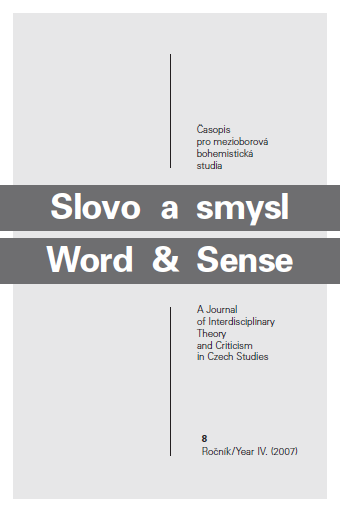Editorial
The eighth issue of Word and Sense bears witness to how reflections on culture and literature can be inspired by recent trends in linguistics that focus on human cognition. These trends emphasize, for instance, conceptual metaphor; physical modes of expressing concepts; linguistics and the mind; categorizations; a general anthropocentrism of language; and questions of universal and cultural relativism.
What can be revealed by language itself (primarily natural language, but other semiotic systems as well) about human perception, the workings of conception, and our experience of the world, which is essentially based entirely on the physical – on what we perceive through the senses? Deep signifying structures of which we are unaware, but which are embedded invisibly somewhere at the origins of our speaking and writing, often provide unexpected evidence of what we are, how we feel, think, and relate to the world, what we experience, and what we reveal and conceal. We live through the mediation of speech: both as human beings, constituted physically and experiencing the world through our senses, and as members of a given cultural community, whose worldview is essentially entirely determined and thus fixed. Against this background it becomes clear that (and how), as Heidegger demonstrates, language itself speaks through people, that (and how) its potential is realized in the speech act, and that (and how) the speech act hints at language as a whole, at culture, and at mankind.
Emphasis on the cognitive and cultural aspects of language, on its ethnological and anthropological dimensions, understood generally, is not a new phenomenon. It is a revival of a long tradition that includes the German pre-Romantic and Romantic philosophies of Herder and Humboldt; Cassirer and his followers; and, in a somewhat different form, American ethnolinguistics, represented by Edward Sapir and Benjamin Whorf. (We also realize how important the idea of language as a concentration of a people’s spirit was in the ideology of the Czech National Revival. Josef Jungmann writes: “Language is the most conspicuous, conforming with each nation’s unique customs, disposition, and inclinations, and philosophy is adapted in accordance with the thousands of differences among nations.”)
There are many different approaches to language that focus in one way or another on its cognitive aspects. They have various names: cognitive linguistics, cultural linguistics, ethnolinguistics, anthropolinguistics. These approaches are usually considered interdisciplinary. Some are based on introspection and experience; others on observation and laboratory experiments; still others study artificial intelligence and the modeling of human thought. Although they are based in the discipline of the natural sciences, they intersect with the humanities, particularly anthropology, insofar as they investigate cultural aspects of human existence – aspects that are shared and that pertain to social values and norms. Here the philosophical implications are evident: phenomenology and hermeneutics; a “subjective” orientation towards meaning that raises questions of intention, categorization, and physicality in relation to speech; subjectivity and thus a dialogical stance in some sense of the word, which may also imply an inclination towards a philosophy of dialogue. The anthropologization of linguistics continues to raise new questions, and attempts to respond to these questions reveal ever new fields of inquiry.
In this issue we have given priority to anthropologically and culturally oriented studies, especially those that treat specific texts, particularly literary texts. Some of our contributors apply the principles discussed above programmatically, e.g. as specialists in cognitive linguistics. The work of others resonates with those principles, although they may not “officially” have much in common with cognitive linguistics, but rather were led through their own life experiences and research in other fields to reflect on the fundamental significance of physicality and the senses and their connection to language.
David Danaher demonstrates the potential for cognitively oriented approaches to the interpretation of literary works in an entirely new way. He interprets Václav Havel’s unique approach to the world and life, to art and politics, in all genres on the basis of traditional “metaphors that we live,” conceptual categories and frameworks. Havel often submits reality to a surprising disclosure, an unmasking, revealing the traditional categories and metaphors in which it is usually safely embedded in our perception: he thus reconceptualizes reality.
From the contributions to this issue of Word and Sense it is evident how cognitive linguistics evolves into cultural linguistics (including comparative aspects), as Laura A. Janda demonstrates. In her article she provides examples (from Russian, Czech, and Polish, sometimes in comparison with English) to show that cognitive linguistics must become a bridge linking the study of linguistic phenomena to the investigation of cultural phenomena. “What is happiness?” asks the well-known cross-cultural Polish and Australian semanticist Anna Wierzbicka. She replies that it is always something slightly different in different cultures, demonstrating how cultural specifics may be understood against the background of universals within the context of cognitive-semantic studies of language and speech norms. This appears as a fundamental problem in today’s multicultural world. With reference to three sets of texts from contemporary magazines, James Underhill examines various conceptualizations of the sex act in three languages (and cultures) – English, German & Czech, concluding that reification predominates. Pavel Jiráček applies cognitively oriented poetics to the problems of a poetic text. The theoretical basis of his analysis is anthropocentrism, which is concealed in orienting metaphors. This approach allows him to reveal how, even in lyric poetry, subjectivity is transcended in the vertical and horizontal form of the text.
The contributions included in the Sketches section also treat subjects that are interesting from the standpoint of cognitive linguistics, such as physicality and modes of conceptualization that develop out of it – i.e., out of the sensuous, the visual, the emotional. In his essay, Miloslav Topinka characterizes Karel Hynek Mácha as a visionary; he thus develops Rimbaud’s “visionary theory” as the essence of artistic creation, and, specifically, as its precondition. The artist as visionary transforms an emotionally, painfully experienced (and consequently indubitable) event in its entirety into a work of art, capturing it simultaneously in both its physicality and its transcendental nature. A special kind of seeing as a conceptual metaphor for perception, knowledge, understanding, and mystical insight is central to Jan Kameník’s remarkable short story, “Cinderella’s Refusal,” an excerpt of which we have included in English translation. Zita El-Dunia presents an interpretation of this story using cognitive tools (conceptual metaphors, mixed spaces). Zděnka Švarcová offers a new understanding of Japanese culture through the conceptualization of rationality and emotionality in both linguistic and cultural coordinates. Martina Musilová, a student of Ivan Vyskočil, who studies various aspects of dialogic interaction, including its philosophical and anthropological implications, reflects in her essay on speaking to oneself in the process of dialogic interaction.
We visited I. Vyskočil, an expert on theater as well as a writer, professor, psychologist, and philosopher, and asked him about dialogic interaction, the discipline he founded. As he states in the interview, the purpose of this psychosomatic discipline is to reveal the authenticity of the individual and human interaction, and it is by no means limited only to acting. One may achieve personal authenticity, revealed in dialogue with an inner partner, through the experience of one’s own physicality, voice, and speech. The emphasis on the physicality of speech, the conception of speech as oral gesture, and the necessity of studying it within an interdisciplinary context and of reflecting on it philosophically makes dialogic interaction fascinating from the standpoint of cognitive linguistics. Vyskočil’s student Michal Čunderle enters the discussion with his own experiences, and in a short excerpt from his prose work Bubela linguistic phenomena come alive, in accordance with the principles of cognitive linguistics.
Some of the articles in this issue concern the meeting point of cognitive linguistics and psycholinguistics or psychology. Jašna Šlédrová presents the work of the first Czech cognitive psychologist – Miluše Sedláková – whose research had a significant impact on Czech psycholinguistics and continues to influence Czech cognitive linguistics to this day. Focusing on the Cognition 2006 conference and its eponymous catalogue, Iva Nebeská writes on methodologies of cognitive linguistics current in interdisciplinary discussions uniting the humanities and the natural sciences. There is an immense variety of possible approaches to human cognition, drawing from realms such as psychology, brain research in neurological studies, and even virtual, computer-simulated models of human thought. As Iva Nebeská shows, this variety of approaches has resulted in the inconsistent usage of key terms such as “cognitive” & “consciousness,” which are used as precisely defined terms in some contexts, but not in others.
Kryzstyna Waszakowa’s reminiscences on the roots of Polish-Czech cooperation in the field of cognitive semantics illuminate the beginnings of cognitive linguistic research in Prague. For greater authenticity we are publishing her work in the original Polish, and we wish to note that it was this linguist from Warsaw University who aroused our interest in the field of research represented in this issue of our journal.
Articles by the leading (and legendary) representatives of Moscow and Lublin ethnolinguistics, Svetlana Tolstaya and Jerzy Bartmiński, which we have translated into Czech in order to make them more accessible to the majority of our readers, show how we may understand the concept of ethnolinguistics in the contemporary context and explain the fundamental principles of the discipline. The various interpretations of the term ethnolinguistics that have been elaborated by Slavic scholars in promising ways illustrate that new horizons are opening up not only for linguistics, but also for other disciplines in the humanities. The article by Jerzy Bartmiński and S. Niebrzegowska-Bartmińska is devoted to the most concrete problems raised by research in Lublin: the definition of the term and so-called “subjective orientation,” which is, in contrast to objectivism, a fundamental principle in the study of meaning and the linguistic image of the world in general. Concluding the translation section is an entry from an ethnological dictionary on the linguistic image of the world as an umbrella concept for this approach to language.
The section Book Reviews and Glosses contains texts by Louis Armand, Tomáš Kubíček, and Uri Margolin on general problems of textual interpretation and of institutionalization, approached through literary theory and philosophical analysis.
Scholars of various ages specializing in a range of disciplines, with different personal and cultural backgrounds, living in different places and writing in different languages, enter into debate in this eighth issue of Word and Sense. They are open to dialogue and gifted with the ability to initiate dialogue, and thus to create a common context shared by all.
Irena Vaňková, Jasňa Šlédrová a Jan Wiendl (Translated by Kirsten Lodge)


